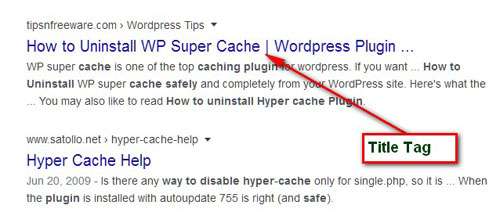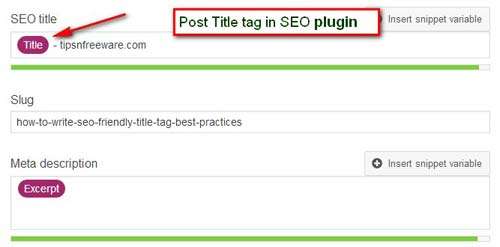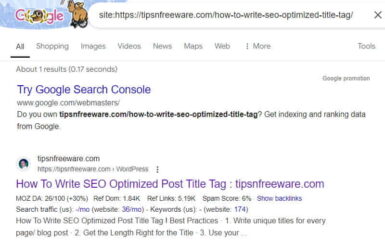Last updated on August 29th,>>>
A well-crafted title tag is your website’s digital handshake. It’s the first impression potential visitors have, and it can significantly impact your search engine rankings and click-through rates (CTRs)
SEO-optimized title tag helps search engines understand your content and entice users to click on your link. SEO-optimized post titles can drive organic traffic, increase brand visibility, and improve your website’s performance.
In this post, we share how to write the perfect SEO-optimized title tag for your blog post.
Here are some best practices, you can follow to craft SEO-optimized title tag.
In a SERP (search engine result page) result page, the blog post’s title is what catches the attention of a visitor. Your blog post title is the title tag for that particular page.
You need to optimize your page titles for search engines to rank well in the SERPs. SEO title optimization is an important factor that search engines use to determine whether or not your page is relevant to a search query.
In short, if you want to boost your rankings, and come up in the first 10 results, you need to pay attention to SEO title optimization.
Additionally, along with meta descriptions and on-page optimization, one of the most important on-page ranking factors you have control over is the title tag. So spend some time before you pen down the title.
Page Contents
What is a SEO optimized Title Tag?
On the search engine results page (SERP), the title ( your post title) is the main part of a site’s listing. Which you see as a clickable headline in the SERPs result, bolded and in blue color.

This is a title tag that you write as an HTML code for your webpage. In the HTML code, they will appear in the <head> section between <title> and </title> tags.

If you are on WordPress and have an SEO plugin installed, you can skip the HTML and add the title tag to your page by filling in the field that’s labeled “ SEO title” or “Title tag” in your plugin displayed at the end of the WordPress editor page.

SEO-friendly title optimization can help you boost your chances of ranking well in the search engine result page.
Title tags are also the first thing that your audience sees once they enter a search query.
Why Title Tags Matter?
Google or for that matter any search engine’s goal is to deliver results that are relevant to the searches people make.
The title tag is one part of the page that’s been given a lot of weight by search engine algorithms in determining what a page is all about. A title tag is a short and simple way for website creators to indicate what’s on the page that follows.
MOZ.COM explains “Title tags are the second most important on-page factor for SEO, after content.”
How to Optimize Your Titles for Search Engines
Writing an SEO- optimized title isn’t hard if you know what works and what doesn’t. Let’s take a look at some of the best practices for SEO title optimization.
1. Write unique titles for every page/ blog post
As a blogger or a content writer, you know that every page on your website is unique and your title tags should reflect that.
Make sure you customize the title tags on each page of your website so that they accurately describe what’s on that specific page.
You want to frame the title tag words in such a way that the search engine bots know what the content of that individual page is about.
Additionally having a clear and accurate title is more useful to anyone who is searching for that particular topic or problem.
For user’s title tag helps to identify the web sites that are likely to contain the information they are searching for within the list of web sites on a SERP
2. Get the Length Right for the Title
Please remember the title tag should not be long, generally, search engines display only the first 50-60 characters of a page’s title in their search results. For this reason, the length of your title plays an important role in SEO title optimization.
You should aim to write title tags that are about 50 characters long or at the most 60 characters. Try to fit in the most important keywords at the beginning of the title tag.
Anything longer than that search engine will chop off, in other words, won’t be displayed in the SERP result.
So, to be safe, place the most important or descriptive words of the keyword toward the beginning so they’re less likely to get cut off.
If you are pressed for space while writing a title, avoid using CAPS as it limits the number of characters that search engines can display.
3. Use your target keyword Find a primary keyword to target
First, find out the most relevant keyword(s) for your brand and niche. Your website will be more useful to those people if it shows up in the search for the right term. So for each page, you should have a target keyword (or a few) in mind.
The best way to include keywords for SEO title optimization is to add them at the beginning of your title.
Search engines do not encourage webmasters to stuff their titles with keywords. Google and other search engines may consider such pages as spammy. It creates a bad user experience so search engines do not see it as a positive strategy.
Title tags allow you to include the main keyword or keywords you’re targeting for that page. This makes it clear to Google that this page is relevant for anyone searching for that specific term.
4. Focus on the descriptiveness of what’s on the page.
Remember search engines are getting smarter. Your post title should accurately describe what the page/post is about and set reader expectations. Try to keep the title tag short as mentioned earlier.
Your finished title tag should not exceed 50–60 characters. You want your title tag to provide an accurate description of what people will see when they choose to visit the web page.
5. Avoiding Stop Words in Your Title Tags
Did you know what are STOP words? Did you know what are the words that Search engines ignore? The common words that you should always avoid using in your Title tag.
Do not use stop words. Stop words are words that are ignored by search engines and (sometimes) users. Try to avoid using commas, whilst commas may look good for the user to scan the content of your page title, using too many may cause search engines to penalize you since they interpret it as keyword stuffing.
Yes, the Search Engine skips common words that are called stop words. to speed up the crawling/indexing process. A stop word can be any of the following (example)
A
And
But
So
On
Or
The
Was
With
Sometimes you might find it difficult to have a title tag without stop words, but if you try different combinations of the same title, you can find them.
you can find a full list of stop words in this link: https://jacobstoops.com/blog/seo-stop-words/
Conclusion
Surprisingly many bloggers and content writers, overlook title tags when you have bigger things to worry as part of your SEO strategy.
But ignoring SEO title optimization can cost you a lot. Your page’s title plays a crucial role in determining how well it will rank in the SERPs.
Website speed is another factor to improve in SERP ranking, you may want to read our 10 definitive ways to speed up a WordPress site in a few minutes.
Thankfully, writing effective page titles doesn’t require much time or effort. But it can give you big results in terms of improving your search rankings.
Crafting and writing SEO-optimized post title tags is a crucial step in optimizing your website’s visibility.I hope this guide will help you to create compelling titles that attract organic traffic and improve your search engine rankings. Remember, consistency and ongoing optimization are key to achieving long-term success.

Hello! I am Ben Jamir, Founder, and Author of this blog Tipsnfreeware. I blog about computer tips & tricks, share tested free Software’s, Networking, WordPress tips, SEO tips. If you like my post /Tips then please like and share it with your friends.






